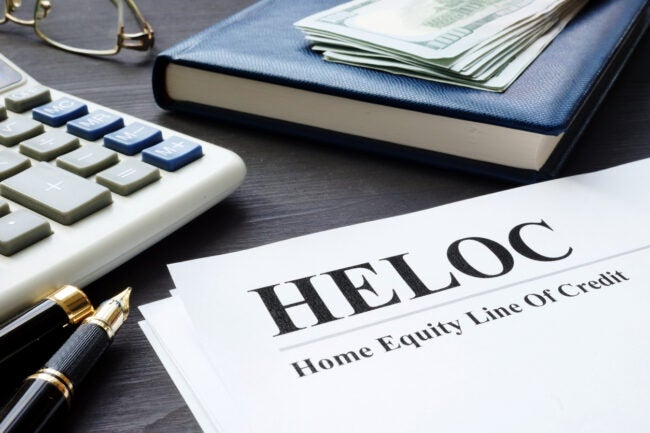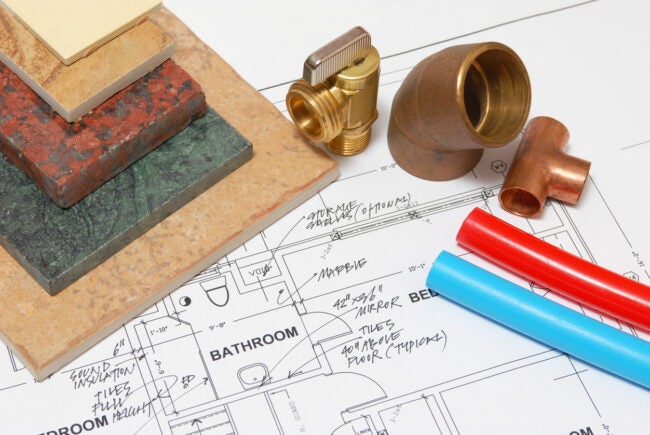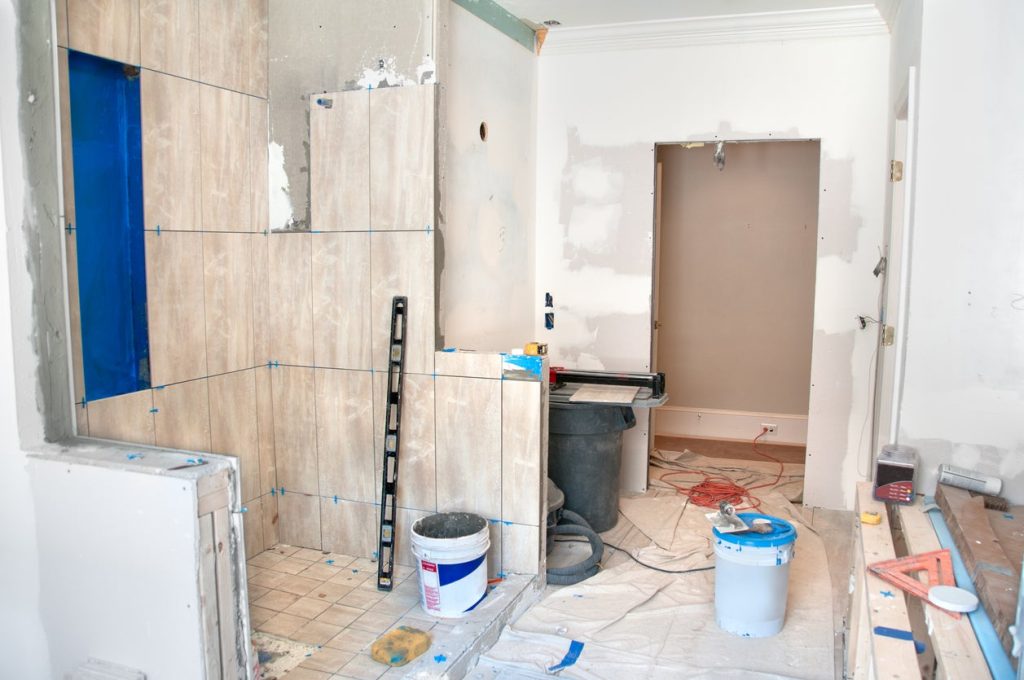Photo: istock.com
Bathroom remodels are on the to-do list for many homeowners, from those who bought fixer-uppers in need of rehab work to those living in older homes with dated features. Additionally, bathroom remodels are one of the best ways to increase the value of a home. The cost of a bathroom remodel isn’t insignificant, however, and can leave some homeowners wondering how they’ll pay for their new bathroom. These 11 steps can help both home buyers and homeowners discover the best way to finance a bathroom remodel, whether that’s through a loan or a line of credit.
Before You Begin…
Bathroom remodel financing options can help homeowners pay for their bathroom upgrades if they don’t have cash on hand to cover those expenses. However, it’s not recommended for borrowers to take on debt they can’t afford—especially if their bathroom remodel is purely cosmetic. Homeowners can avoid unnecessary debt by carefully considering their financial situation, remodel plans, and financing options. It may make sense for a homeowner to choose a small bathroom remodel project with high ROI over a complete renovation to cut down on costs.
In addition, homeowners who finance bathroom remodel projects will want to compare the total costs of different financing options. The fees associated with different types of loans, not to mention the interest rate, could increase the project’s overall cost.
STEP 1: Figure out how much money you need for a bathroom remodel.
It’s a good idea for homeowners to add up their potential bathroom remodel costs before jumping into one of the best home improvement loans. Knowing the expected cost of a bathroom remodel project in advance makes it easier for homeowners to choose the right type of financing. The average cost to remodel a bathroom is $11,398, but this price can range from $6,621 to $16,773. However, the cost of bathroom renovations varies based on several factors, such as whether the homeowner decides to take on the project as a DIY bathroom remodel or hires one of the best bathroom remodeling companies like Granite and TREND Transformations. Using a bathroom remodel cost estimator or consulting a contractor experienced in bathroom remodeling could help homeowners better anticipate the cost of their project.

Photo: istock.com
STEP 2: Assess your financial situation to see what kind of loan or line of credit you might qualify for.
There are many ways to finance a bathroom remodel, but a homeowner may not qualify for every type of financing available. A full financial assessment can help homeowners narrow down what types of home improvement loans or lines of credit might work for them.
Factors for homeowners to consider when looking at their finances include:
- Savings,
- Credit score,
- Debt-to-income (DTI) ratio, and
- Home equity.
To qualify for a home equity loan or home equity line of credit (HELOC), a borrower needs to have a minimum amount of equity in their home. For this reason, these financing options may be impractical for borrowers and new home buyers who have not yet built up much equity in their home.
A homeowner’s credit score is often one of the biggest factors that will determine whether they will qualify for a bathroom remodel loan or not. Homeowners can improve their chances of securing bathroom remodel financing by checking that their credit score meets lenders’ minimum loan requirements. Those with lower credit scores may want to work on increasing their score before applying for financing by making on-time payments to credit cards and paying down existing debt.
DTI ratios are another important factor that lenders weigh when considering loan applications. A borrower’s DTI represents the amount of their monthly income spent on existing debt. Individuals with higher DTI ratios will have more difficulty qualifying for loans and favorable lending terms.

Photo: istock.com
STEP 3: Consider a home equity loan to finance bathroom renovations using your built-up equity.
Homeowners who have paid off a sizable portion of their mortgage may be able to tap into their home equity (which is the difference between what a homeowner owes on their mortgage and what the home is worth) to pay for renovations and bring their bathroom remodel ideas to life. Home equity loans allow borrowers to access their built-up equity to finance renovation projects or pay for various other expenses. Depending on the lender, homeowners may be able to borrow up to 85 percent of their equity. For instance, if a homeowner has $100,000 in home equity, they may qualify for a loan up to $85,000.
Home equity loans are a lump-sum financing option that usually have a fixed rate and repayment period. The risk of a home equity loan, however, is that the home is used as collateral. If the borrower defaults on their loan payments, the lender could seize the home and sell it to recoup those losses. Despite that potential risk, a home equity loan could be a great option for homeowners who have established a good amount of equity in their home and who feel confident about their ability to make monthly payments for the duration of the loan.
STEP 4: Open a home equity line of credit to withdraw funds on an as-needed basis.
Like a home equity loan, a home equity line of credit (HELOC) uses the borrower’s home equity to provide funding. However, HELOCs differ from home equity loans in two major ways. First, a HELOC provides revolving credit, similar to a credit card. Borrowers are given a credit limit based on their equity and can borrow as much as they need up to the limit. As with a credit card, the homeowner pays down their balance plus interest charges. When the balance is paid down, additional credit is freed up that the homeowner can use as needed.
The second difference between home equity loans and HELOCs is that HELOCs often have variable interest rates. This means the interest rate can go up or down based on current market conditions. Because HELOCs can have long repayment periods, borrowers could see their interest rates fluctuate significantly over that time.
STEP 5: Ask your mortgage lender about a cash-out refinance if you’re also looking to change the terms of your home loan.
A cash-out refinance replaces the existing mortgage on a home while tapping into the homeowner’s equity and giving them a lump-sum payment. The way it works is that a homeowner takes out a new mortgage for the remaining balance of the existing mortgage plus any equity that the homeowner wishes to convert into funds. For instance, if a borrower owns a home valued at $400,000 with $100,000 remaining on their mortgage, they would have $300,000 worth of equity available. Because lenders often require cash-out refi borrowers to leave at least 20 percent of the home’s market value as equity in the property, the homeowner in this case could potentially receive up to $220,000 as a lump-sum payment (leaving $80,000 of equity in their home). If a homeowner wants to remodel their bathroom at a cost of $15,000, they could refinance their mortgage with a new loan amount of $115,000 (the remaining $100,000 on their principal plus the money required for the renovation).
A cash-out refinance may be a good bathroom remodel financing option for homeowners who also want to change their mortgage terms. By refinancing, homeowners can take advantage of potentially better home loan terms, such as lowering their interest rate, reducing monthly payments, or removing mortgage insurance. Lenders may have minimum equity requirements for borrowers to obtain a cash-out refinance, much like a HELOC or home equity loan. Additionally, homeowners may want to consider the cost of taking out a new mortgage, such as appraisal fees, title insurance costs, origination fees, and other closing costs. These expenses could add thousands of dollars to the total cost of a loan.

Photo: istock.com
STEP 6: Look into FHA 203(k) rehab loans if you’re buying a house in need of renovations.
Homeowners looking to purchase a fixer-upper may be able to get bathroom remodel financing through a government-backed loan program. The Federal Housing Administration’s 203(k) rehab loan program lets home buyers roll their home’s purchase price and renovation costs into one mortgage. The FHA doesn’t provide loans directly for the program. Instead, homeowners work with private mortgage lenders who participate in the program.
There are two types of 203(k) rehab loans: standard and limited. Standard loans require a minimum improvement amount of $5,000 and often cap loan amounts at 110 percent of the home’s estimated value after repairs are made. Limited loans have no minimum improvement amount but provide a maximum of $35,000 to cover repairs. The limited 203(k) loan program is generally best for smaller projects. For example, shower remodel costs can run anywhere from $200 to $15,000, making them good candidates for FHA 203(k) financing. With this loan option, a home buyer could purchase a fixer-upper and remodel a small bathroom while bundling their renovation costs into their mortgage.
STEP 7: Check with construction loan companies for financing options to cover your bathroom remodel costs.
Some mortgage lenders specialize in loans to build new homes, which are known as construction loans. While construction loans are generally used to build a house from the ground up, some of the best construction loan lenders offer remodeling and renovation loans as well. This type of home improvement loan may be best suited for a larger project as loan amounts tend to be higher.
Another option for homeowners to consider is bathroom remodeling companies that finance projects themselves. Some renovation companies that specialize in bathroom remodels may offer special financing deals, such as bathroom financing with no credit check. If a homeowner doesn’t need to remodel their bathroom right away, it could pay off to wait for a remodeling company to run a limited-time promotion. For instance, a home renovation company might run a promotion for a bathroom remodel with no payments for 2 years.

Photo: istock.com
STEP 8: Explore unsecured home improvement loans—but keep an eye out for high interest rates.
Loans that require collateral are known as secured loans. For example, a home equity loan uses the house as collateral. If the borrower doesn’t repay the loan, the lender may be able to seize the home. An unsecured loan, on the other hand, doesn’t require the borrower to put forward any collateral. Some homeowners may qualify for an unsecured personal loan or home improvement loan to complete their bathroom remodel based on their credit score and other criteria.
Unsecured home improvement loans generally have fixed interest rates and payment terms, which may be appealing to those who find the complexities of HELOCs, cash-out refinances, and other equity-based options to be too confusing to navigate. However, homeowners may want to be aware of the potentially high costs of an unsecured loan. Lenders often use higher interest rates or loan fees for unsecured loans to help lower their financial risk if the borrower stops making payments.
STEP 9: Find a credit card company offering low introductory rates on new accounts.
Homeowners with strong credit profiles might be able to take advantage of a financing option they’re likely already familiar with: a credit card. Many credit card companies offer attractive introductory rates for new cardholders. For example, a homeowner might qualify for a 0 percent interest rate for the first 12 months. Homeowners who can pay off their remodel project within the introductory period can essentially finance their renovation without paying interest or other fees. Additionally, many credit cards offer nearly instant approval, so qualified homeowners can get the funds they need fast.
However, it’s a good idea for those planning to use a credit card to pay for bathroom renovations to have a solid repayment plan in place. Any credit card balance left at the end of the promotional period is subject to a high interest rate. If the balance isn’t paid off in time, the homeowner could end up spending much more than planned on their remodel project from interest charges alone. In addition, not all bathroom remodel contractors accept credit cards as a form of payment, so this option may not be feasible in all cases.

Photo: istock.com
STEP 10: Shop around, compare financing terms, and apply for a loan or line of credit.
After figuring out the cost of their project and learning about available financing terms, homeowners can narrow down their options to those that make the most sense for their bathroom remodel. While less expensive renovations may not require homeowners to go to the lengths of obtaining a cash-out refinance, for example, homeowners probably won’t want to pay for a $20,000 bathroom renovation with a credit card. Next, homeowners are encouraged to get financing information from multiple lenders. This gives homeowners the chance to carefully compare financing terms between lenders, such as interest rates or loan repayment terms.
When hiring one of the best home renovation contractors, it’s a good idea for homeowners to find out what types of payments are accepted. As noted, a contractor may not take credit cards, which could put a bathroom remodel on hold if the homeowner had planned on charging their renovation costs to their credit card. Making sure a contractor accepts the homeowner’s preferred payment option can save a lot of headaches when it’s time to pay the bill.
STEP 11: Get access to your funds, cover your bathroom remodeling expenses, and repay your loan.
Homeowners may want to talk with their lender about the funding process and expected timeline. Depending on the type of financing a homeowner chooses, the application and funding process could take up to several weeks. For example, equity-based financing, such as a home equity loan or cash-out refinance, will likely take longer to fund than a personal loan. Asking the lender for clarification can give the borrower a better idea of when funds will be accessible for their bathroom remodel project.
In addition, homeowners will want to understand their repayment options before agreeing to loan terms. Some bathroom remodel financing options come with straightforward monthly payments that never change during the repayment period. Other options, such as HELOCs, may have variable interest rates that can lead to an ever-changing monthly payment, so it’s a good idea for homeowners to verify how loan payments are calculated. In addition, many lenders offer autopay options that automatically make loan payments each month by transferring money from the borrower’s bank account, which may be appealing to borrowers who don’t want to worry about scheduling monthly payments.
These 11 steps can help homeowners confidently compare their bathroom renovation financing options. To get the most out of this loan-shopping process, homeowners may want to start by estimating the cost of their remodel. It’s also a good idea for homeowners to understand their financial situation, including their credit score and DTI ratio. By understanding their finances, homeowners can make informed decisions to find a bathroom remodel loan or line of credit that fits their needs and budget.
Read the full article here














